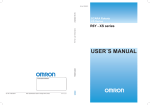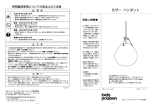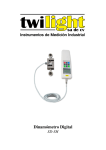Download Yamaha 150Z User`s manual
Transcript
YAMAHA SCARA ROBOT YK-X series YK-XS User’s Manual ENGLISH E YAMAHA MOTOR CO., LTD. IM Operations 882 Soude, Naka-ku, Hamamatsu, Shizuoka 435-0054.Japan URL http://www.yamaha-motor.jp/robot/index.html E24-Ver. 2.14 Introduction This user’s manual was prepared for YK-XS series ceiling-mount models (YK300XHS to YK1000XS) of the YAMAHA industrial robots. This user’s manual describes the safety measures, handling, adjustment and maintenance of YK-XS series robots for correct, safe and effective use. Be sure to read this manual carefully before installing the robot. Even after you have read this manual, keep it in a safe and convenient place for future reference. This user’s manual should be used with the robot and considered an integral part of it. When the robot is moved, transferred or sold, send this manual to the new user along with the robot. Be sure to explain to the new user the need to read through this manual. For the operating or maintenance procedures not described in this manual, please refer to the separate “YK-X Series User’s Manual”. Also refer to the “YK-X Series User’s Manual” for precautions and warranty. If there are any obscure points in handling the robot, be sure to contact YAMAHA sales office or dealer. For details on specific operation and programming of the robot, refer to the separate “YAMAHA Robot Controller User’s Manual”. NOTES • The contents of this manual are subject to change without prior notice. • Information furnished by YAMAHA in this manual is believed to be reliable. However, if you find any part unclear or inaccurate in this manual, please contact YAMAHA sales office or dealer. YAMAHA MOTOR CO., LTD. IM Operations MEMO CONTENTS CHAPTER 1 Functions 1 Robot Manipulator ..................................................... 1-1 2 Robot Parameters ..................................................... 1-4 CHAPTER 2 Installation 1 Installation Base ........................................................ 2-1 2 Installation ................................................................. 2-2 2-1 Unpacking ............................................................................................ 2-2 2-2 Checking the product ........................................................................... 2-3 2-3 Moving the robot .................................................................................. 2-4 2-3-1 Moving the YK300XHS, YK400XHS ...................................................... 2-4 2-3-2 Moving the YK500XS, YK600XS, YK700XS, YK800XS, YK1000XS ..... 2-5 CHAPTER 3 2-3-2-1 Moving the ceiling-mount robot .............................................. 2-5 2-3-2-2 Moving the inverted ceiling-mount robot .............................. 2-10 Periodic Inspection 1 Replacing the Harmonic Grease (Inverted ceiling-mount model R-axis) ...................... 3-1 1-1 Replacement period ............................................................................. 3-1 CHAPTER 4 Specifications 1 Robot Manipulator ..................................................... 4-1 1-1 Basic specifications .............................................................................. 4-1 1-1-1 Ceiling-mount model .............................................................................. 4-1 1-1-2 Inverted ceiling-mount model ................................................................. 4-4 1-2 External view and dimensions ............................................................. 4-6 MEMO CHAPTER 1 Functions 1 Robot Manipulator ................................................................. 1-1 2 Robot Parameters .................................................................. 1-4 MEMO CHAPTER 1 Functions 1 Robot Manipulator YK-XS series robots are grouped into the ceiling-mount models of Fig. 1-1 and the inverted ceiling-mount models of Fig. 1-2. Jog key movement is in the directions shown in Figs. 1-1 and 1-2. Robot part names and functions are shown in Fig. 1-3 and Fig. 1-4. Y-axis arm X-axis arm (+) (-) (+) (-) (-) Z-axis (+) Y-axis X-axis (-) R-axis (+) Fig. 1-1 Ceiling-mount model (-) R-axis (+) X-axis arm (+) Z-axis X-axis Y-axis (-) (+) (-) (-) (+) Y-axis arm Fig. 1-2 Inverted ceiling -mount model 1-1 CHAPTER 1 Functions D-sub connector for user wiring (No.1 to 10) M4 ground terminal D-sub connector for user wiring (No.1 to 10) Serial label User tubing 1 (φ 4 black) User tubing 2 (φ 4 red) User tubing 1 (φ4 black) User tubing 3 (φ 4 blue) User tubing 2 (φ4 red) Machine harness User tubing 3 (φ4 blue) Ball screw Robot cable Warning label 1 Warning label 3 Warning label 2 R-axis motor X-axis motor Z-axis motor Y-axis motor X-axis speed reduction gear Y-axis arm R-axis speed reduction gear Z-axis spline End effector attachment Y-axis speed reduction gear Y-axis mechanical stopper X-axis mechanical stopper X-axis arm Z-axis,R-axis pulley, belt Fig. 1-3 YK300XHS, YK400XHS ceiling-mount robots In the case of the inverted ceiling-mount models, the robot base up/down installation directions in the figure are reversed. 1-2 CHAPTER 1 Functions Y-axis mechanical stopper User tubing 2 (φ6 red) User tubing 3 (φ6 blue) D-sub connector for user wiring (No.1 to 20) User tubing 1 (φ6 black) Robot cable Warning label 2 (Same on opposite side) Warning label 1 (Same on opposite side) User tubing 3 (φ6 blue) Ball screw User tubing 2 (φ6 red) User tubing 1 (φ6 black) D-sub connector for user wiring (No.1 to 20) M4 ground terminal Machine harness Serial label R-axis motor Z-axis motor Y-axis motor Warning label 3 X-axis motor Y-axis speed reduction gear R-axis speed reduction gear Z-axis spline X-axis speed reduction gear Y-axis arm Z-axis,R-axis pulley, belt End effector attachment X-axis arm Carrying jig installation position Machine harness X-axis movable mechanical stopper Fig. 1-4 YK500XS to YK1000XS ceiling-mount robots In the case of the inverted ceiling-mount models, the robot base up/down installation directions in the figure are reversed. 1-3 CHAPTER 1 Functions 2 Robot Parameters A portion of the robot parameters for ceiling-mount models and inverted ceilingmount models are changed from the standard specifications when shipped. The following is a description of these changed parameters and precautions you should take when using these robots. To purchasers of this robot At this time our sincere thanks for your purchase of this robot. This robot is made to custom specifications so some parameters are different from standard robots. Please be aware of the following points before attempting to use the robot. Cautions regarding use Always make a backup of parameters. Initializing the parameters voids all parameters that were entered. When initialized, load the backup parameters. Parameter changes A description of parameter changes is given below. Boxes left blank indicate standard specifications. (1) Ceiling-mount model Axis settings Parameter Axis parameters 16. Motor direction Changes Y-axis Z-axis R-axis X-axis Changes Y-axis Z-axis +++ R-axis --- Axis settings (YK300XHS, YK400XHS) Parameter X-axis Axis parameters 37. Max. motor rotation Changes Y-axis Z-axis X-axis +++ (2) Inverted ceiling-mount models Axis settings Parameter Axis parameters 16. Motor direction Axis settings (YK500XS, YK600XS, YK700XS, YK800XS, YK1000XS) Parameter Changes X-axis Y-axis Z-axis Axis parameters 37. Max. motor rotation 1-4 R-axis 6000 R-axis 4000 CHAPTER 1 Functions (3) YK300XHS Axis settings Parameter Axis parameters 11. Arm length [mm] X-axis 175.00 Changes Y-axis Z-axis 125.00 Note that the model name “YK350X” is shown on the nameplate of the YK300XHS. Robot numbers used to initialize the parameters are as follows Robot numbers 2101 2102 2103 2104 2105 2106 2107 2110 2111 2112 2113 2114 Robot model YK300XHS YK400XHS YK500XS Z200 YK600XS Z200 YK700XS Z200 YK800XS Z200 YK1000XS Z200 YK500XS Z300 YK600XS Z300 YK700XS Z400 YK800XS Z400 YK1000XS Z400 Manufacturer serial No. Controller serial No. 1-5 R-axis MEMO 1-6 CHAPTER 2 Installation 1 Installation Base .................................................................... 2-1 2 Installation .............................................................................. 2-2 2-1 2-2 2-3 Unpacking .................................................................................................. 2-2 Checking the product ................................................................................. 2-3 Moving the robot ........................................................................................ 2-4 2-3-1 Moving the YK300XHS, YK400XHS ........................................................... 2-4 2-3-2 Moving the YK500XS, YK600XS, YK700XS, YK800XS, YK1000XS .......... 2-5 2-3-2-1 Moving the ceiling-mount robot ..................................................... 2-5 2-3-2-2 Moving the inverted ceiling-mount robot ..................................... 2-10 MEMO CHAPTER 2 Installation 1 Installation Base 1) Please read the description of standard robot models for the installation base and comply with the caution items provided. WARNING The ceiling-mount robot models are hung from the ceiling so a dangerous situation can occur if the robot support section breaks and the robot falls. Make sure the robot support section has sufficient strength, rigidity and safety. ! CAUTION • When using the YK300XHS and YK400XHS, make sure that the arm does not interfere with the base installation section. • When using the YK500XS to YK1000XS, make sure that the machine harness and Y-axis arm upper cover do not interfere with the base installation section. See “1-2 External view and dimensions” in Chapter 4. 2) Tap the required holes into the surface of the installation base. See “1-2 External view and dimensions” in Chapter 4 for how to tap the holes. 2-1 CHAPTER 2 Installation 2 Installation 2-1 Unpacking WARNING The robot and controller are heavy. Take sufficient care not to drop them during moving or unpacking as this may damage the equipment or cause bodily injury. ! CAUTION When moving the robot or controller by equipment such as a folk-lift that requires a license, only properly qualified personnel may operate it. The equipment and tools used for moving the robot should be serviced daily. The YK-X series robot comes packed with a robot controller and accessories, according to the order specifications. Using a carrying cart (dolly) or forklift, move the package to near the installation base. Take sufficient care not to apply shocks to the equipment when unpacking it. Robot manipulator YK500XS, YK600XS, YK700XS, YK800XS, YK1000XS Ceiling-mount models Case Robot manipulator YK300XHS, YK400XHS Arm clamping stay (Remove after installation.) Robot carrying jig Arm clamping stay (Remove after installation.) Robot controller and accessories Robot manipulator Fig. 2-1 Packed state 2-2 YK500XS, YK600XS, YK700XS, YK800XS,YK1000XS Inverted ceiling-mount models CHAPTER 2 Installation 2-2 Checking the product After unpacking, check the product configuration and conditions. The illustration below shows typical configurations for YK500XS to YK1000XS ceiling-mount and inverted ceiling-mount models, which are different from standard models. ! CAUTION If there is any damage due to transportation or insufficient parts, please notify your YAMAHA sales office or dealer immediately. Controller : RCX240 Robot : YK500XS, YK600XS, YK700XS, YK800XS, YK1000XS STD. DIO connector ( × 1) RPB terminator ( × 1) CD-ROM manual Warning label ( × 1) Robot manipulator YK-XS series D-sub connector/hood ( × 2) 40 OP.3 OP.1 MO TOR RCX2 RPB R PW SRV ERR XM RO I/O YM BATT XY B XY SEL RO I/O CO M A X Z B OP.4 OP.2 P N ZR STD.D ACIN IO L ZM BATT ZR N SAFE TY B Y R Origin position stickers ( × 2) (YK500XS,YK600XS × 3) L1 N1 RM Covers ( × 2) OP E-ST 14 EXT. 13− PIN Screws ( × 4) RCX240 Fig. 2-2 Product configurations 2-3 CHAPTER 2 Installation 2-3 Moving the robot WARNING Serious injury may occur if the robot falls and pins someone under it. • Do not allow any part of your body to enter the area beneath the robot during work. • Always wear a helmet, safety shoes and gloves during work. To check the mass of each robot, refer to “1-1 Basic specifications” in Chapter 4. 2-3-1 Moving the YK300XHS, YK400XHS 1) Fold the X and Y axis arms as shown in Fig. 2-3, and wind the robot cable around the machine harness, then fasten the robot cable with adhesive tape so as not to cover the bolt installation holes. When moving an inverted ceiling mount robot, wind the robot cable around the spline shaft as shown and fasten the cable with adhesive tape. 2) Holding the support parts as shown in the figure with both hands, place the robot on the installation base and secure it temporarily by tightening the bolts. (For tightening torque to secure the robot firmly, see “2-4 Installing the robot” in the YK-X standard model user’s manual.) Robot cable Robot cable Bolt installation hole Support part Support part Support part Bolt installation hole Support part Fig. 2-3 2-4 CHAPTER 2 Installation 2-3-2 Moving the YK500XS, YK600XS, YK700XS, YK800XS, YK1000XS WARNING Serious injury may occur if the robot falls and pins someone under it. • Check that there are no cracks and corrosion on the eyebolt installation. If found, do not use eyebolts to move the robot. • Insert the eyebolts into the holes of the carrying jig so that their bearing surfaces make tight contact with each other, and securely fasten the eyebolts with the nuts. • Use a hoist and rope with carrying capacity strong enough to support the robot weight. • Make sure the rope stays securely on the hoist hook. • Remove all loads attached to the robot manipulator end. If any load is still attached, the robot may lose balance while being carried, and topple over causing accidents. ! CAUTION • When moving the robot by equipment such as cranes that require a license, only properly qualified personnel may operate it. • The equipment and tools used for moving the robot should be serviced daily. To move a robot (for example, the YK500XS) correctly and safely, follow the procedure below. Use the same procedure to move other robots. 2-3-2-1 Moving the ceiling-mount robot (1) When using eyebolts (See Fig. 2-4.) 1) Remove the X-axis and Y-axis under covers and attach the carrying jigs as shown in Fig. 2-4. Remove all loads if attached to the Z-axis to set the servo free and release the brake. Then fold the Z-axis to a position where it can be fastened to the arm clamping stay 2) Insert the eyebolts into the holes on the carrying jig and securely fasten the eyebolts with the nuts. Then attach the arm clamping stay to the carrying jig. 3) Clamp the Y-axis arm by using the stay and bolts that come with the robot. If the arms cannot be folded in the carrying position (see Fig. 2-4) due to the Xaxis mechanical stoppers, then remove them. (When the robot is shipped, the mechanical stoppers are installed to provide the maximum movement range.) 4) Wind the robot cable around the robot base while keeping the cable from hanging up on the base mount, then fasten the cable end with adhesive tape. 2-5 CHAPTER 2 Installation 5) Prepare 4 looped ropes with the same length to allow a good lifting balance, then pass each rope through each eyebolt and catch it on the hoist hook. 6) Slightly lift the hoist so that each rope has light tension to hold the robot. In this state, remove the bolts securing the robot base to the pallet supplied or installation base (if robot is to be moved to another installation base). 7) Using caution to keep the balance of the robot and avoid subjecting it to any strong vibrations and shocks, operate the hoist carefully to move to the installation base. The angle between each rope and the arm surface should be kept at 45 degrees or more. 8) Temporarily secure the robot to the installation base by tightening the bolts. (Use the same tightening torque as specified to secure the standard model robots.) 9) Remove the ropes and carrying jigs, then reattach the X-axis and Y-axis under covers. Be sure to keep the carrying jigs, eyebolts, arm clamping stay, bolts and pallet for future use in case the robot needs to be moved or transported. 2-6 CHAPTER 2 Installation Arm clamping stay (supplied with robot) Eyebolts (4 pieces supplied with the robot) Arm clamped position Bolts (M12×20) supplied with robot Tightening torque 71N•m (720kgf•cm) Hoist hook Rope Robot cable Use bolts and nuts or screws (4 pcs) supplied with robot 4 bolts (supplied with robot) Tightening torque 71N•m (720kgf•cm) Robot carrying jig Pallet (supplied with the robot) Bolts (2 pcs) supplied with robot Tightening torque 4.5N•m (46kgf•cm) Y-axis under cover Fig. 2-4 2-7 Screw X-axis under cover CHAPTER 2 Installation (2) When using the hand forklift (See Fig. 2-5) 1) Remove the X- and Y-axis under covers and install the robot carrying jigs. 2) Set the X- and Y-axis arms straight (See Fig. 2-5). If the robot is in the shipped state, remove the spline from the arm clamping stay, and set the X- and Yaxis arms straight. If the arms cannot be folded in the carrying position (see Fig. 2-5) due to the X-axis mechanical stoppers, then remove them. 3) Wind the robot cable around the robot base while keeping the cable from hanging up on the base mount, then fasten the cable end with adhesive tape. 4) Insert the prongs of the hand forklift into the robot carrying jigs and raise the hand forklift supporting the robot. Remove the bolts securing the pallet supplied or installation base (if moving the robot to another installation base). 5) Using caution to keep the balance of the robot and avoid subjecting it to vibrations and shocks, slowly move to the installation base. 6) Temporarily secure the robot to the installation base by tightening the bolts. (Bolt tightening torque is the same as the standard model robots.) 7) Remove the carrying jigs, and reattach the X- and Y-axis under covers. Be sure to keep the carrying jigs, bolts, arm clamping stay and pallet for future use in case the robot needs to be moved or transported. 2-8 CHAPTER 2 Installation Set the arms out straight. Arm clamping stay (supplied with robot) Arm clamped position Bolts (M12×20) supplied with robot Robot cable 4 bolts (supplied with robot) Tightening torque 71N•m (720Kgf•cm) Use bolts and nuts or screws (4 pcs) supplied with robot Robot carrying jig Insert the prongs of the hand forklift there. Pallet (supplied with the robot) Bolts (2 pcs) supplied with robot Y-axis under cover Fig. 2-5 2-9 Screw X-axis under cover CHAPTER 2 Installation 2-3-2-2 Moving the inverted ceiling-mount robot (1) When using eyebolts (See Fig. 2-6.) 1) Remove the X-axis and Y-axis upper covers and attach the robot carrying jigs. Remove all loads if attached to the Z-axis to set the servo free and release the brake. Then fold the Z-axis to a position where it can be fastened to the arm clamping stay 2) Insert the eyebolts into the holes on the carrying jigs and securely fasten the eyebolts with the nuts. Then attach the arm clamping stay to the carrying jigs. 3) Clamp the Y-axis arm by using the stay and bolts that come with the robot. If the arms cannot be folded in the carrying position (see Fig. 2-4) due to the Xaxis mechanical stoppers, then remove them. (When the robot is shipped, the mechanical stoppers are installed to provide the maximum movement range.) 4) Wind the robot cable around the robot base while keeping the cable from hanging up on the base mount, then fasten the cable end with adhesive tape. 5) Prepare 4 looped ropes with the same length to allow a good lifting balance, then pass each rope through each eyebolt and catch it on the hoist hook. 6) Slightly lift the hoist so that each rope has light tension to hold the robot. In this state, remove the bolts securing the robot base to the pallet supplied or installation base (if moving the robot to another installation base). 7) Using caution to keep the balance of the robot and avoid subjecting it to any strong vibrations and shocks, operate the hoist carefully to move to the installation base. The angle between each rope and the arm surface should be kept at 45 degrees or more. 8) Temporarily secure the robot to the installation base by tightening the bolts. (Bolt tightening torque is the same as the standard model robots.) 9) Remove the ropes and carrying jigs, then reattach the X-axis and Y-axis upper covers. Be sure to keep the carrying jigs, eyebolts, arm clamping stay, bolts and pallet for future use in case the robot needs to be moved or transported. 2-10 CHAPTER 2 Installation Hoist hook X-axis upper cover Y-axis upper cover Rope Screw Eyebolts (4 pieces supplied with the robot) 2 bolts (supplied with robot) Tightening torque 4.5N•m (46kgf•cm) Robot carrying jig 4 bolts (supplied with robot) Tightening torque 71N•m (720kgf•cm) Robot cable Use bolts and nuts or screws supplied with robot Pallet (supplied with the robot) Bolts (M12×20) supplied with robot Tightening torque 71N•m (720kgf•cm) Arm clamping stay (supplied with robot) Arm clamped position Fig. 2-6 2-11 CHAPTER 2 Installation (2) When using the hand forklift (See Fig. 2-7) 1) Remove the X- and Y-axis upper covers and install the robot carrying jigs. 2) Set the X- and Y-axis arms straight (See Fig. 2-5). If the robot is in the shipped state, remove the spline from the arm clamping stay, and set the X- and Yaxis arms straight. If the arms cannot be folded in the carrying position (see Fig. 2-5) due to the X-axis mechanical stoppers, then remove them. (When the robot is shipped, the mechanical stoppers are installed to provide the maximum movement range.) 3) Wind the robot cable around the robot base while keeping the cable from hanging up on the base mount, then fasten the cable end with adhesive tape. 4) Insert the prongs of the hand forklift into the robot carrying jigs and raise the hand forklift supporting the robot. Remove the bolts securing the pallet supplied or installation base (if moving the robot to another installation base). 5) Using caution to keep the balance of the robot and avoid subjecting it to vibrations and shocks, slowly move to the installation base. 6) Temporarily secure the robot to the installation base by tightening the bolts. (Bolt tightening torque is the same as the standard model robots.) 7) Remove the carrying jigs, and reattach the X- and Y-axis upper covers. Be sure to keep the carrying jigs, bolts, arm clamping stay and pallet for future use in case the robot needs to be moved or transported. 2-12 CHAPTER 2 Installation X-axis upper cover Y-axis upper cover Screw Eyebolts (4 pieces supplied with the robot) 2 bolts (supplied with robot) Insert the prongs of the hand forklift there. Insert the prongs of the hand forklift there. Robot carrying jig 4 bolts (supplied with robot) Tightening torque 71N•m (720kgf•cm) Robot cable Use bolts and nuts or screws supplied with robot Pallet (supplied with the robot) Bolts (M12×20) supplied with robot Arm clamping stay (supplied with robot) Set the arms out straight. Arm clamped position Fig. 2-7 2-13 MEMO 2-14 CHAPTER 3 Periodic Inspection 1 Replacing the Harmonic Grease (Inverted ceiling-mount model R-axis) ................................... 3-1 1-1 Replacement period ................................................................................... 3-1 MEMO CHAPTER 3 Periodic Inspection 1 Replacing the Harmonic Grease (Inverted ceiling-mount model R-axis) Only the R-axis harmonic drive of the inverted ceiling-mount model uses harmonic grease HC-1A. This grease must be replaced periodically. Use the guideline explained below to determine the appropriate replacement period and replace the grease. 1-1 Replacement period The harmonic drive grease replacement period is determined by the total number of turns of the wave generator used in the harmonic drive. It is recommended to replace the harmonic drive grease when the total number of turns has reached 1.5×108 (at ambient operating temperatures of 0°C to +40°C). This means that the replacement period will differ depending on the following operating conditions. If the robot operation duty ratio is high or the robot is operated in environments at higher temperatures, the harmonic drive should be replaced earlier. Replacement period = where n : θ : N : h : D : 1.5×108/(n×60×h×D×N×θ) years Number of axis movements per minute Average turn per axis movement Speed reduction ratio Operation time per day Operation days per year For example, when the robot is used under the following conditions, the replacement period for the R-axis harmonic drive grease of the YK500X can be calculated as follows. n : 10 θ : 0.25 N : 80 h : 24 hours per day D : 240 days per year Replacement period = 1.5×108/(n×60×h×D×N×θ) = 1.5×108/(10×60×24×240×80×0.25) = 2.17 years Table 3-1 Harmonic drive speed reduction ratio Robot model R-axis YK300XHS,YK400XHS 50 YK500XS,YK600XS 50 YK700XS,YK800XS 50 YK1000XS 50 3-1 MEMO 3-2 CHAPTER 4 Specifications 1 Robot Manipulator ................................................................. 4-1 1-1 1-2 Basic specifications .................................................................................... 4-1 1-1-1 Ceiling-mount model ................................................................................... 4-1 1-1-2 Inverted ceiling-mount model ...................................................................... 4-4 External view and dimensions .................................................................... 4-6 MEMO CHAPTER 4 Specifications 1 Robot Manipulator 1-1 Basic specifications 1-1-1 Ceiling-mount model Robot model X-axis Axis specifications Y-axis Z-axis YK300XHS YK400XHS Arm length 175mm 225mm Rotation angle ±115° ±115° Arm length 125mm 175mm Rotation angle ±140° ±140° Stroke 150mm 150mm ±360° ±360° X-axis 200W 200W Y-axis 100W 100W Z-axis 100W 100W R-axis Rotation angle Motor Maximum speed Repeatability *1 R-axis 100W 100W XY resultant 4.4m/s 6.0m/s Z-axis 1.0m/s 1.0m/s R-axis 1020°/s 1020°/s XY-axes ±0.01mm ±0.01mm Z-axis ±0.01mm ±0.01mm R-axis ±0.005° ±0.005° 3kg 3kg Payload R-axis tolerable moment of inertia *2 0.05kgm2 (0.5kgfcms2) User wiring 0.2sq×10cables User tubing φ4×3 Travel limit 1.Soft limit 2.Mechanical limit (XYZ-axes) Robot cable Standard: 3.5m Option: 5m, 10m Weight 15kg *1 At constant ambient temperature (XY) *2 There are limits to acceleration coefficient settings. 4-1 15kg CHAPTER 4 Specifications Robot model X-axis Axis specifications Y-axis Z-axis YK500XS YK600XS Arm length 250mm 350mm Rotation angle ±120° ±120° Arm length 250mm 250mm Rotation angle ±135° ±145° Stroke 200, 300mm 200, 300mm ±360° ±360° X-axis 400W 400W Y-axis 200W 200W R-axis Rotation angle Motor Maximum speed Repeatability *1 Z-axis 200W 200W R-axis 100W 100W XY resultant 4.9m/s 5.6m/s Z-axis 1.7m/s 1.7m/s R-axis 876°/s 876°/s XY-axes ±0.02mm ±0.02mm Z-axis ±0.01mm ±0.01mm R-axis ±0.005° ±0.005° Payload 10kg R-axis tolerable moment of inertia *2 10kg 0.12kgm (1.2kgfcms2) 2 User wiring 0.2sq×20cables User tubing φ6×3 Travel limit 1.Soft limit 2.Mechanical limit (XYZ-axes) Robot cable Standard: 3.5m Option: 5m, 10m Weight 30kg *1 At constant ambient temperature (XY) *2 There are limits to acceleration coefficient settings. 4-2 32kg CHAPTER 4 Specifications Robot Model X-axis Axis specifications Y-axis Z-axis Arm length Maximum speed Repeatability *1 YK800XS YK1000XS 350mm 450mm 550mm Rotation angle ±120° ±120° ±120° Arm length 350mm 350mm 450mm Rotation angle ±145° ±145° ±145° Stroke 200, 400mm 200, 400mm 200, 400mm ±360° ±360° ±360° X-axis 800W 800W 800W Y-axis 400W 400W 400W Z-axis 400W 400W 400W R-axis Rotation angle Motor YK700XS R-axis 200W 200W 200W XY resultant 6.7m/s 7.3m/s 8.0m/s Z-axis 1.7m/s 1.7m/s 1.7m/s R-axis 600°/s 600°/s 600°/s X,Y-axes ±0.02mm ±0.02mm ±0.02mm Z-axis ±0.01mm ±0.01mm ±0.01mm R-axis ±0.005° ±0.005° ±0.005° 20kg 20kg Payload 20kg R-axis tolerable moment of inertia *2 0.32kgm2 (3.2kgfcms2) User wiring 0.2sq×20cables User tubing φ6×3 Travel limit 1.Soft limit 2.Mechanical limit (XYZ-axes) Robot cable Standard: 3.5m Option: 5m, 10m Weight 56kg 57kg *1 At constant ambient temperature (XY) *2 There are limits to acceleration coefficient settings. 4-3 58kg CHAPTER 4 Specifications 1-1-2 Inverted ceiling-mount model YK300XHS YK400XHS YK500XS YK600XS Arm length 175mm 225mm 250mm 350mm Rotation angle ±115° ±115° ±120° ±120° Arm length 125mm 175mm 250mm 250mm Rotation angle ±140° ±140° ±135° ±145° Stroke 150mm 150mm ±360° ±360° ±360° ±360° X-axis 200W 200W 400W 400W Y-axis 100W 100W 200W 200W Robot model X-axis Axis specifications Y-axis Z-axis R-axis Rotation angle Motor Maximum speed Repeatability *1 Z-axis 100W 100W 200W 200W R-axis 100W 100W 100W 100W XY resultant 4.4m/s 6.0m/s 4.9m/s 5.6m/s Z-axis 1.0m/s 1.0m/s 1.7m/s 1.7m/s R-axis 720°/s 720°/s 480°/s 480°/s XY-axes ±0.01mm ±0.01mm ±0.02mm ±0.02mm Z-axis ±0.01mm ±0.01mm ±0.01mm ±0.01mm R-axis ±0.005° ±0.005° ±0.005° ±0.005° 3kg 3kg 10kg Payload R-axis tolerable moment of inertia *2 User wiring 200, 300mm 200, 300mm 10kg 0.05kgm (0.5kgfcms ) 0.12kgm (1.2kgfcms2) 0.2sq×10cables 0.2sq×20cables φ4×3 φ6×3 2 User tubing 2 2 Travel limit 1.Soft limit 2.Mechanical limit (XYZ-axes) Robot cable Standard: 3.5m Option: 5m, 10m Weight 15kg 15kg *1 At constant ambient temperature (XY) *2 There are limits to acceleration coefficient settings. 4-4 30kg 32kg CHAPTER 4 Specifications Robot Model X-axis Axis specifications Y-axis Z-axis Arm length Maximum speed Repeatability *1 YK800XS YK1000XS 350mm 450mm 550mm Rotation angle ±120° ±120° ±120° Arm length 350mm 350mm 450mm Rotation angle ±145° ±145° ±145° Stroke 200, 400mm 200, 400mm 200, 400mm ±360° ±360° ±360° X-axis 800W 800W 800W Y-axis 400W 400W 400W Z-axis 400W 400W 400W R-axis Rotation angle Motor YK700XS R-axis 200W 200W 200W XY resultant 6.7m/s 7.3m/s 8.0m/s Z-axis 1.7m/s 1.7m/s 1.7m/s R-axis 480°/s 480°/s 480°/s X,Y-axes ±0.02mm ±0.02mm ±0.02mm Z-axis ±0.01mm ±0.01mm ±0.01mm R-axis ±0.005° ±0.005° ±0.005° 20kg 20kg Payload 20kg R-axis tolerable moment of inertia *2 0.32kgm2 (3.2kgfcms2) User wiring 0.2sq×20cables User tubing φ6×3 Travel limit 1.Soft limit 2.Mechanical limit (XYZ-axes) Robot cable Standard: 3.5m Option: 5m, 10m Weight 56kg 57kg *1 At constant ambient temperature (XY) *2 There are limits to acceleration coefficient settings. 4-5 58kg CHAPTER 4 Specifications 1-2 External view and dimensions The drawing below is for the ceiling-mount robots. The inverted ceiling-mount robots also have the same dimensions. 112.2 78.7 70 D-sub connector for user wiring 42 M4 ground terminal 131 D-sub connector for user wiring 38 (No.1 to 10) (No.1 to 10) R5 13 52 74 55 140 0 65 125 175 100 37 12 .5 User tubing 1 (φ4 black) 39 R User tubing 2 (φ4 red) User tubing 3 (φ4 blue) User tubing 1 (φ4 black) User tubing 2 (φ4 red) User tubing 3 (φ4 blue) 40 72 103 381 290 230 187 135 25 185.5 168 0 15 36 φ54 Z-axis upper end mechanical stopper position 4-φ9 Use M8 bolt for installation 62 52 φ31 Z-axis lower end mechanical stopper position φ16h7 M8×1.25 Depth 15 7 150 Z-axis stroke 5 142±2 0 -0.018 Fig. 4-1 YK300XHS 4-6 120 CHAPTER 4 Specifications (Use this when tightening M8 φ3 +0.2 0 screw at lower part.) Z-axis mechanical stopper 36(φ16 Range) 41 Circlip for user tool positioning Spline shaft (hollow) Hollow diameter φ7 0 φ16h7 -0.018 M8×1.25 Depth15 Z-axis tip shape 140 ° 5° 11 5° 11 ° 140 R3 00 13 R1 R1 25 86° 86° 226 Base interference range Working envelope Use caution to prevent interference with installation wall Inverse type is installed upside down. 4-7 CHAPTER 4 Specifications 166.1 225 85.3 72 M4 ground terminal 131 D-sub connector for user wiring (No.1 to 10) 38 R5 13 55 74 60 140 0 65 175 42 D-sub connector for user wiring (No.1 to 10) 100 37 R3 9 .5 12 User tubing 1 (φ4 black) User tubing 1 (φ4 black) User tubing 2 (φ4 red) 40 User tubing 2 (φ4 red) User tubing 3 (φ4 blue) 72 103 User tubing 3 (φ4 blue) 381 290 230 187 0 15 36 4-φ9 Use M8 bolt 62 for installation φ54 5 52 φ 31 Z-axis upper end mechanical stopper position 150 Z-axis stroke 25 185.5 135 168 142±2 φ16h7 0 -0.018 M8×1.25 Depth 15 7 Z-axis lower end mechanical stopper position Fig. 4-2 YK400XHS 4-8 120 CHAPTER 4 Specifications (Use this when tightening M8 φ3 +0.2 0 screw at lower part.) Z-axis mechanical stopper 41 36(φ16 Range) Circlip for user tool positioning Spline shaft (hollow) Hollow diameter φ7 0 φ16h7 -0.018 M8×1.25 Depth15 Z-axis tip shape 45 R1 11 5° 11 5° 14 0° 0° 14 R4 00 96° 226 96° Base interference range Working envelope Use caution to prevent interference with installation wall Inverse type is installed upside down. 4-9 CHAPTER 4 Specifications 47 120 250 90 94 User tubing 3 (φ6 blue) R5 User tubing 2 (φ6 red) 5 250 D-sub connector for user wiring (No.1 to 20) User tubing 1 (φ6 black) φ205 (Installation base of larger than φ205mm may interfere with harness.) 228 Z300mm stroke Recommended user installation base 93 Z200mm stroke 60 8 0 15 91 36 2X2-M4X0.7 Depth10 (Same on opposite side) 284 Z-axis upper end mechanical stopper position 54 20 319 φ7 8 41 48 364 411±2 0 φ18 -0.018 A 200 M12×1.75 Depth 20 12 0 Z-axis 300mm stroke Working envelope 0 R8 R2 Center of recommended user installation base 65 70 12 110 R200 65 86 Z-axis 200mm stroke Working envelope Z-axis lower end mechanical stopper position 160 300 517 8 57 73 166 (Base size) View from direction A Fig. 4-3 YK500XS 4-10 4-φ11 Use M10 bolt for installation CHAPTER 4 Specifications 0° 12 R1 91 0° 00 Interference position (a) Base flange (b) Base rear side (c) Base R5 12 R93( R111(c) a) 50 R2 (b) R67 135° 135° 3 R1 8 12 3(c) a) 5( R8 2° 0 R10 12 R50 2° Working envelope R250 R59(b) 137° 137° X and Y-axis mechanical stopper positions (maximum working envelope) 2 0 0 35 55 73 53 User tubing 3(φ6 blue) D-sub connector for user wiring (No.1 to 20) User tubing 2(φ6 red) User tubing 1(φ6 black) M4 ground terminal 4-11 CHAPTER 4 Specifications User tubing 2 (φ6 red) 120 94 User tubing 3 (φ6 blue) 350 90 250 R55 47 D-sub connector for user wiring (No. 1 to 20 usable) User tubing 1 (φ6 black) φ205 (Installation base of larger than φ205mm may interfere with harness.) 228 Z-axis 300mm stroke Recommended user installation base Z-axis 200mm stroke 93 60 8 0 15 91 36 2X2-M4X0.7 Depth10 (Same on opposite side) Z-axis upper end mechanical stopper position 54 φ7 20 319 8 48 41 364 411±2 φ18 -0.018 0 A 527 Center of recommended user installation base 70 12 R200 Z-axis lower end mechanical stopper position 160 Z-axis stroke 300mm Working envelope 86 110 65 12 0 0 R2 R8 Z-axis stroke 200mm Working envelope 65 300 200 M12X1.75 Depth20 8 57 73 166(Base size) View from direction A Fig. 4-4 YK600XS 4-12 4-φ11 Use M10 bolt for installation R106(a) R 60 0 12 R1 24 (c) 0° 12 Interference position (a) Base flange (b) Base rear side (c) Base 0° CHAPTER 4 Specifications 04 R2 50 R2 R8 0(b ) ° 145 145° 2° 12 00 6(c) 96 2° R11 R6 12 R116(a) Working envelope R1 R2 50 ) 2(b R7 147° 147° X and Y-axis mechanical stopper positions (maximum working envelope) 2 0 0 35 55 73 53 User tubing 3 (φ6 blue) D-sub connector for user wiring (No. 1 to 20 usable, pin contact) User tubing 2 (φ6 red) User tubing 1 (φ6 black) M4 ground terminal 4-13 CHAPTER 4 Specifications User tubing 1 (φ6 black) User tubing 2 (φ6 red) D-sub connector for user wiring(No. 1 to 20 usable) User tubing 3 (φ6 blue) 350 350 147 R76 106 126 58 φ232 (Installation base of larger than φ232mm may interfere with harness.) 301 Z-axis 400mm stroke Recommended user installation base 120 101 Z-axis 200mm stroke 5 0 20 2X2-M4X0.7 Depth10 (Same on opposite side) 41 97 279 54 φ8 20 328 45 375 8 419±2 0 φ22 -0.021 M12X1.75 Depth20 562 Z-axis stroke 200mm Working envelope 12 R1 0 R15 4-φ14 Use M12 bolt for installation 0 75 12 70 112 Z-axis stroke 400mm Working envelope 5 06 R2 75 400 200 A 180 50.5 Z-axis upper end mechanical stopper position Z-axis lower end mechanical stopper position 70 106 80 93 View from direction A Fig. 4-5 YK700XS 4-14 Center of recommended user installation base CHAPTER 4 Specifications ) 5(a R9 R3 5 0 12 R7 00 (c) 0° 04 12 R1 10 R2 0° Interference position (a) Base flange (b) Base rear side (c) Base R60(b ) 145° 145° 00 R7 12 ) 3(a R8 R3 50 ) 3° 3(c 99 R1 R9 12 3° Working envelope b) 8( R4 147° 147° X and Y-axis mechanical stopper positions (maximum working envelope) 4 0 0 41 61 79 59 D-sub connector for user wiring (No. 1 to 20 usable, pin contact) User tubing 3 (φ6 blue) User tubing 2 (φ6 red) User tubing 1 (φ6 black) 4-15 CHAPTER 4 Specifications User tubing 1 (φ6 black) User tubing 2 (φ6 red) User tubing 3 (φ6 blue) D-sub connector for user wiring (No. 1 to 20 usable) 350 450 147 R76 106 126 58 φ232 (Installation base of larger than φ232mm may interfere with harness.) 301 Z-axis 400mm stroke Recommended user installation base 120 101 Z-axis 200mm stroke 5 0 20 2X2-M4X0.7 Depth10 (Same on opposite side) 41 97 279 54 φ8 20 328 375 8 45 50.5 Z-axis upper end mechanical stopper position 419±2 0 φ22 -0.021 M12X1.75 Depth20 200 A 0 4-φ14 Use M12 bolt for installation 5 06 R2 75 R15 70 112 0 12 75 Z-axis stroke 300mm Working envelope 180 12 R1 400 562 Z-axis stroke 200mm Working envelope Z-axis lower end mechanical stopper position 70 106 80 93 View from direction A Fig. 4-6 YK800XS 4-16 Center of recommended user installation base CHAPTER 4 Specifications Interference position (a) Base flange (b) Base rear side (c) Base 12 00 R8 59 53 (c) 0° 0° 12 R2 R1 R143(a) 50 R3 ) 8(b 0 R1 145° 145° R131 12 3° 47 41 (c) R8 3° R2 R1 12 (a) Working envelope 00 50 R3 ) 6(b R9 147° 147° X and Y-axis mechanical stopper positions (maximum working envelope) 4 0 0 41 61 79 59 D-sub connector for user wiring (No. 1 to 20 usable, pin contact) User tubing 3 (φ6 blue) User tubing 2 (φ6 red) User tubing 1 (φ6 black) 4-17 CHAPTER 4 Specifications User tubing 1 (φ6 black) User tubing 2 (φ6 red) D-sub connector for user wiring (No. 1 to 20 usable) User tubing 3 (φ6 blue) 550 450 147 R76 106 126 58 φ232 (Installation base of larger than φ232mm may interfere with harness.) 301 Z-axis 400mm stroke Recommended user installation base 133 101 Z-axis 200mm stroke 5 0 20 2X2-M4X0.7 Depth10 (Same on opposite side) 41 97 279 54 φ8 20 328 375 45 8 50.5 Z-axis upper end mechanical stopper position 419±2 0 φ22-0.021 M12X1.75 Depth20 562 Z-axis stroke 200mm Working envelope 75 R15 Z-axis stroke 300mm Working envelope 0 75 12 06 0 4-φ14 Use M12 bolt for installation 5 180 R1 R2 70 112 12 400 200 A Z-axis lower end mechanical stopper position 70 106 80 93 View from direction A Fig. 4-7 YK1000XS 4-18 Center of recommended user installation base ) 00 R1 0 (c 0° 12 09 15 R2 R3 Interference position (a) Base flange (b) Base rear side (c) Base 12 0° CHAPTER 4 Specifications (a) R200 50 R4 (b) 65 R1 145° 145° R1 00 0 a) 84( R1 R4 50 12 (c) 3° 94 12 R1 00 R3 3° Working envelope (b) 49 R1 147° 147° X and Y-axis mechanical stopper positions (maximum working envelope) 4 0 0 41 61 79 59 D-sub connector for user wiring (No. 1 to 20 usable, pin contact) User tubing 3 (φ6 blue) User tubing 2 (φ6 red) User tubing 1 (φ6 black) 4-19 User's Manual YK-X series SCARA Robot YK-XS Mar. 2010 Ver. 2.14 This manual is based on Ver. 2.15 of Japanese manual. © YAMAHA MOTOR CO., LTD. IM Operations All rights reserved. No part of this publication may be reproduced in any form without the permission of YAMAHA MOTOR CO., LTD. Information furnished by YAMAHA in this manual is believed to be reliable. However, no responsibility is assumed for possible inaccuracies or omissions. If you find any part unclear in this manual, please contact YAMAHA or YAMAHA sales representatives.

































































